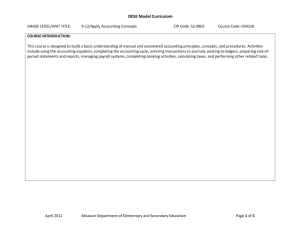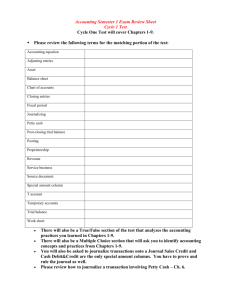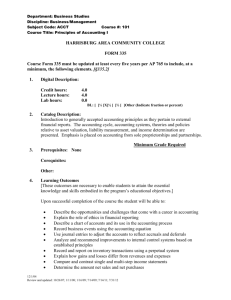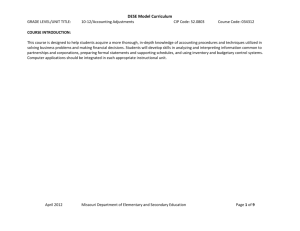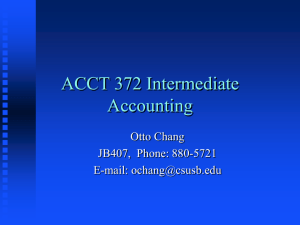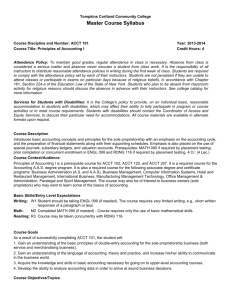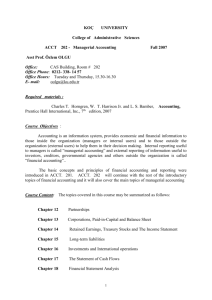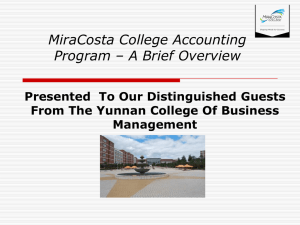BE DVD ROM 14 - Accounting Equation
advertisement
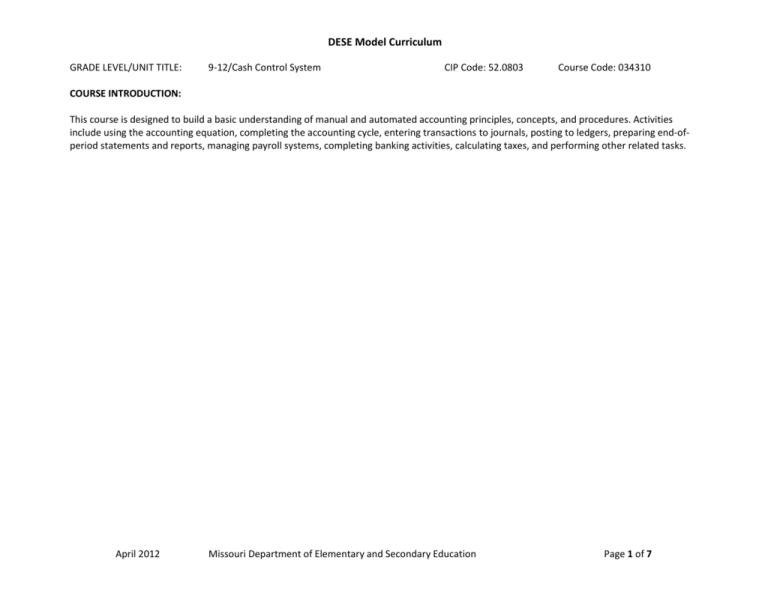
DESE Model Curriculum GRADE LEVEL/UNIT TITLE: 9-12/Cash Control System CIP Code: 52.0803 Course Code: 034310 COURSE INTRODUCTION: This course is designed to build a basic understanding of manual and automated accounting principles, concepts, and procedures. Activities include using the accounting equation, completing the accounting cycle, entering transactions to journals, posting to ledgers, preparing end-ofperiod statements and reports, managing payroll systems, completing banking activities, calculating taxes, and performing other related tasks. April 2012 Missouri Department of Elementary and Secondary Education Page 1 of 7 DESE Model Curriculum GRADE LEVEL/UNIT TITLE: 9-12/Cash Control System CIP Code: 52.0803 Course Code: 034310 UNIT DESCRIPTION: SUGGESTED UNIT TIMELINE: 3 weeks The student will be able to: Define accounting terms related to using a checking account and a petty cash fund; Identify accounting concepts and practices related to using a checking account; Prepare business papers related to using a checking account; Reconcile a bank statement; Journalize dishonored checks and electronic banking transactions; Establish and replenish a petty cash fund. CLASS PERIOD (min.): 50 Minutes ESSENTIAL QUESTIONS: A. What are the objectives of efficient cash management and the controls associated with the asset cash? B. How does a sole proprietorship maintain cash systems – checking account and petty cash fund? C. Why should a business reconcile its bank statement? ESSENTIAL MEASURABLE LEARNING OBJECTIVES CCSS LEARNING GOALS (Anchor Standards/Clusters) CROSSWALK TO STANDARDS GLEs /CLEs 1. Define terminology related to cash control and banking activities 2. Identify cash control procedures (e.g. signature cards and deposit slips. 3. Write checks April 2012 Missouri Department of Elementary and Secondary Education PS CCSS NBEA DOK L.11-12.6 RI.11-12.4 RST.11-12.4 RH.11-12.4 L.11-12.2b RST.11-12.3 ACCT.IV.A.3-4.2 ACCT.IV.E.3-4.1 ACCT.IV.F.3-4.1 1 ACCT.IV.E.3-4.2 2 L.11-12.2b RST.11-12.3 ACCT.IV.F.3-4.2 2 Page 2 of 7 DESE Model Curriculum GRADE LEVEL/UNIT TITLE: 9-12/Cash Control System CIP Code: 52.0803 4. Maintain a check register 5. Endorse checks 6. Explain the process for proving cash 7. Prove cash 8. Reconcile a bank statement 9. Journalize transactions to establish and replenish petty cash 10. Post journal entries to establish and replenish petty cash 11. Journalize entries related to banking activities 12. Post entries related to banking activities April 2012 Missouri Department of Elementary and Secondary Education Course Code: 034310 A-CED.1 N-Q.1 RST.11-12.3 L.11-12.2b RST.11-12.3 RI.11-12.7 RST.11-12.1 A-CED.1 N-Q.1 RI.11-12.7 RST.11-12.3 A-CED.1 N-Q.1 RI.11-12.7 RST.11-12.3 A-CED.1 N-Q.1 RI.11-12.7 RST.11-12.3 A-CED.1 N-Q.1 RST.11-12.3 A.CED.1 A-SSE.1 N-Q.1 RI.11-12.7 RST.11-12.3 A-CED.1 ACCT.IV.F.3-4.2 2 ACCT.IV.E.3-4.2 2 ACCT.III.3-4.1 2 ACCT.IV.E.3-4.2 2 ACCT.III.3-4.1 3 ACCT.IV.E.3-4.2 ACCT.IV.F.3-4.2 4 ACCT.V.3-4.2 3 ACCT.IV.E.3-4.2 ACCT.IV.G.3-4.3 ACCT.IV.B.3-4.2 4 ACCT.V.3-4.2 3 Page 3 of 7 DESE Model Curriculum GRADE LEVEL/UNIT TITLE: 9-12/Cash Control System CIP Code: 52.0803 13. Journalize entries related to cash short and over 14. Post entries related to cash short and over Course Code: 034310 N-Q.1 RST.11-12.3 A-CED.1 N-Q.1 RI.11-12.7 RST.11-12.3 A-CED.1 N-Q.1 RST.11-12.3 ACCT.IV.E.3-4.2 ACCT.IV.F.3-4.2 ACCT.IV.A.3-4.2 4 ACCT.V.3-4.2 3 ASSESSMENT DESCRIPTIONS*: (Write a brief overview here. Identify Formative/Summative. Actual assessments will be accessed by a link to PDF file or Word doc. ) Utilize South-Western textbook objective tests (summative) http://www.accountingxtra.swlearning.com Utilize South-Western textbook performance tests (summative) http://www.accountingxtra.swlearning.com South-Western Accounting textbook companion website. http://www.accountingxtra.swlearning.com *Attach Unit Summative Assessment, including Scoring Guides/Scoring Keys/Alignment Codes and DOK Levels for all items. Label each assessment according to the unit descriptions above ( i.e., Grade Level/Course Title/Course Code, Unit #.) Obj. # INSTRUCTIONAL STRATEGIES (research-based): (Teacher Methods) 1 1. Teacher will present new terminology related to cash control and banking activities 2 2. The teacher will present new material in small steps, model and provide guided practice, review the material, question students to connect new material to prior learning, check for understanding, and then monitor guided practice to prepare signature cards and deposit slips. 3 3. The teacher will present new material in small steps, model and provide guided practice, review the material, question students to connect new material to prior learning, check for understanding, and then monitor guided practice to complete a check stub and write checks. April 2012 Missouri Department of Elementary and Secondary Education Page 4 of 7 DESE Model Curriculum GRADE LEVEL/UNIT TITLE: 9-12/Cash Control System CIP Code: 52.0803 Course Code: 034310 4 4. The teacher will present new material in small steps, model and provide guided practice, review the material, question students to connect new material to prior learning, check for understanding, and then monitor guided practice to maintain a check register. 5 5. The teacher will present new material in small steps, model and provide guided practice, review the material, question students to connect new material to prior learning, check for understanding, and then monitor guided practice to endorse checks using a blank endorsement, special endorsement, or restrictive endorsement. 6,7 6. The teacher will present new material in small steps, model and provide guided practice, review the material, question students to connect new material to prior learning, check for understanding, and then monitor guided practice to prove cash. 8 7. The teacher will present new material in small steps, model and provide guided practice, review the material, question students to connect new material to prior learning, check for understanding, and then monitor guided practice to reconcile a bank statement. 9, 12, 13, 14 8. The teacher will present new material in small steps, model and provide guided practice, review the material, question students to connect new material to prior learning, check for understanding, and then monitor guided practice to journalize and post entries to establish and replenish petty cash. 11, 12 9. The teacher will present new material in small steps, model and provide guided practice, review the material, question students to connect new material to prior learning, check for understanding, and then monitor guided practice to journalize and post entries to record voided checks and bank service charges. 11, 12 10. The teacher will present new material in small steps, model and provide guided practice, review the material, question students to connect new material to prior learning, check for understanding, and then monitor guided practice to journalize and post entries to record a dishonored check and electronic banking transactions. Obj. # INSTRUCTIONAL ACTIVITIES: (What Students Do) 1 1. The student will be able to define terminology related to cash control and banking activities 2 2. The student will be able to prepare signature cards and deposit slips. 3 3. The student will be able to complete a check stub and write checks. April 2012 Missouri Department of Elementary and Secondary Education Page 5 of 7 DESE Model Curriculum GRADE LEVEL/UNIT TITLE: 9-12/Cash Control System CIP Code: 52.0803 Course Code: 034310 4 4. The student will be able to maintain a check register. 5 5. The student will be able to endorse checks using a blank endorsement, special endorsement, or restrictive endorsement. 6,7 6. The student will be able to prove cash. 8 7. The student will be able to reconcile a bank statement. 9, 12, 13, 14 8. The student will be able to journalize and post entries to establish and replenish petty cash. 11, 12 9. The student will be able to journalize and post entries to record voided checks and bank service charges. 11, 12 10. The student will be able to journalize and post entries to record a dishonored check and electronic banking transactions. UNIT RESOURCES: (include internet addresses for linking) South-Western Accounting textbook companion website. http://www.accountingxtra.swlearning.com www.Quia.com Bank Reconciliation practice problem-- http://www.accountingcoach.com/online-accounting-course/13Xpg02.html http://www.accountingcrosswords.com/bank-reconciliation.php Checkbook writing activities-- http://www.moneyinstructor.com/checks.asp Petty Cash Training Video--https://www.youtube.com/watch?v=nRy2TGmTicc www.uen.org www.superteachertools.com Resources @ MCCE: BE 13.0301 N213.1 - National Standards For Business Education - National Business Education Association, RESTON, VA, NATIONAL BUSINESS EDUCATION ASSOCIATION, 2007. The revised and updated National Standards for Business Education state what all K-14 students should know and be able to do in business. These national standards contain guidelines for a quality education in 11 content areas of business education; accounting, business law, career development, communication, computation, economics and personal finance, entrepreneurship, information technology, international business, management, and marketing. Each content area incorporates achievement standards and accompanying performance expectations. Each achievement standard states the understanding and competency students should attain. Each performance April 2012 Missouri Department of Elementary and Secondary Education Page 6 of 7 DESE Model Curriculum GRADE LEVEL/UNIT TITLE: 9-12/Cash Control System CIP Code: 52.0803 Course Code: 034310 expectation delineates what students need to do to exhibit the knowledge and the skills required to meet the achievement standard. BE 13.1303 D243 - Accountivities: Real-World Reinforcement Activities for First-Year Accounting Students - Nancy deLisle, WARWICK, RI, B.E. PUBLISHING, 2009. This book is a collection of activities designed to reinforce the accounting skills learned in a first year accounting course. Each activity in the book is designed to cover a specific set of skills. Activities range in size and scope from choosing the appropriate form of business ownership to completing the accounting cycle for a merchandising business. BE 13.1303 T171 - Games Accounting Teachers Play - Joy Tavano, Editor, WARWICKM RI, BUSINESS EDUCATION PUBLISHING, 2006. This book includes a collection of games, activities, and strategies--from debits and credits and T-accounts to journalizing entries and the accounting equation. Organized into six accounting instructional categories: Bulletin boards and visual reinforcements; Classroom discussion generators; Accounting games; Hands-on activities; Creative projects and assessments; Accounting teaching tips and resources. BE DVD ROM 14 - Accounting Equation - Teacher's Video Company, SCOTTSDALE, AZ, TEACHER'S VIDEO COMPANY, 2001. A thorough understanding of the accounting equation provides a solid foundation for your students' business studies. Clear explanations and interesting examples teach students about balance sheets, general ledgers, assets, liabilities, equities, and more. Grades 9-12. Approximately 22 minutes. BE DVD ROM 34 - On the Money: The ABCs of Accounting Introductions and Definitions - Cambridge Educational, LAWRENCEVILLE, NJ, CAMBRIDGE EDUCATIONAL, 2002. When it comes to finances, "approximately" is just not good enough. Accounting professionals are expected to understand all the ins and outs of money matters, applying the rules of accountancy with good sense and care. With that in mind, this program starts with the basics, introducing the purpose of accounting, identifying the AICPA and FASB, explaining the concept of GAAP, and spelling out the differences between CPAs and CMAs. After contrasting three types of business organizations, the program moves on to the actual process of recording and tracking transactions. 15 minutes. April 2012 Missouri Department of Elementary and Secondary Education Page 7 of 7
